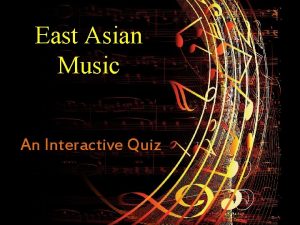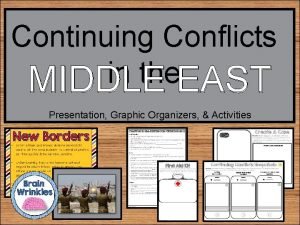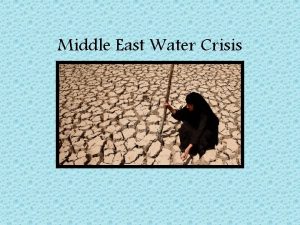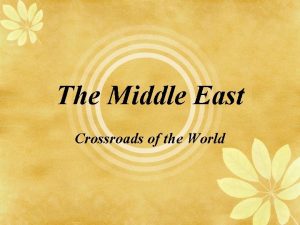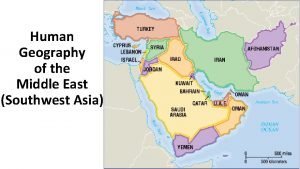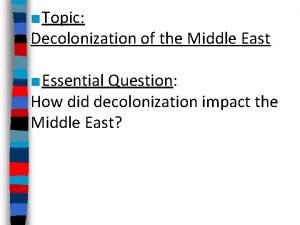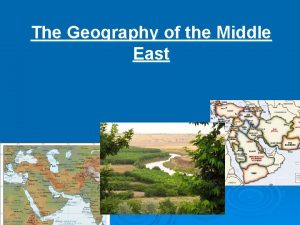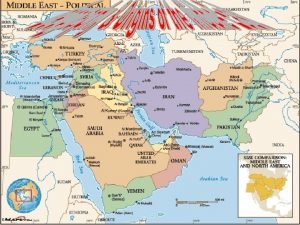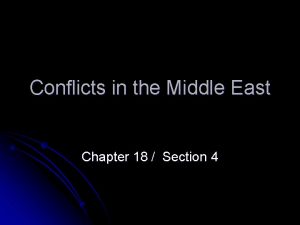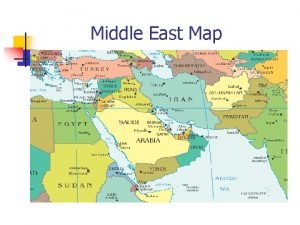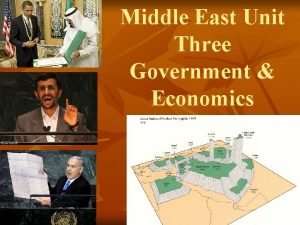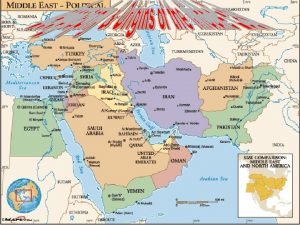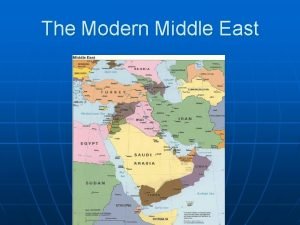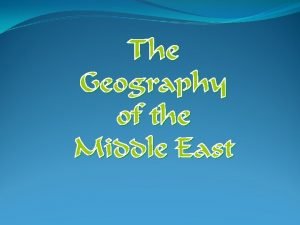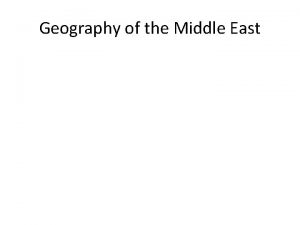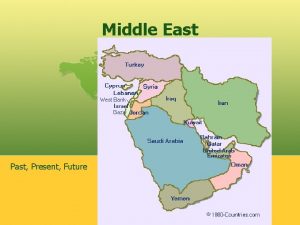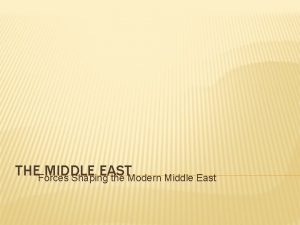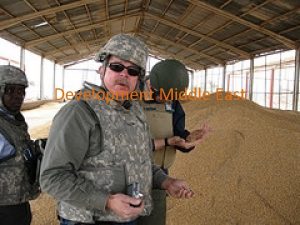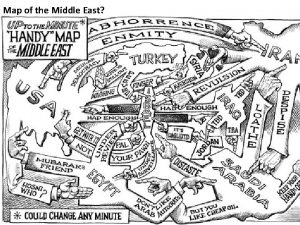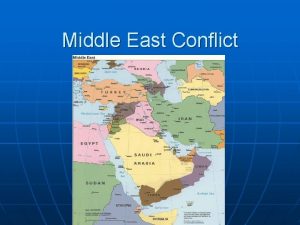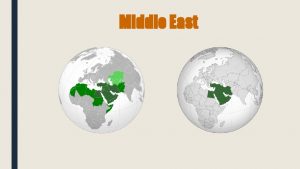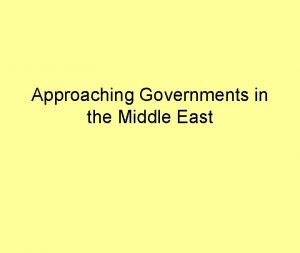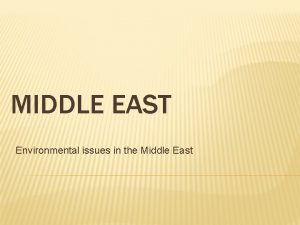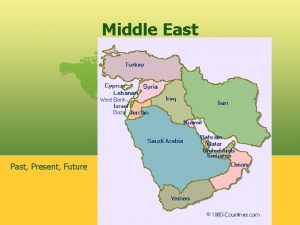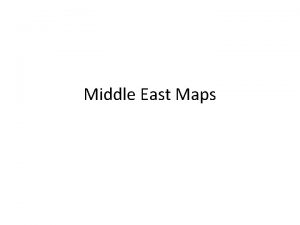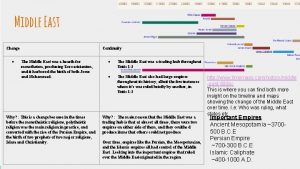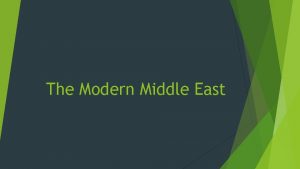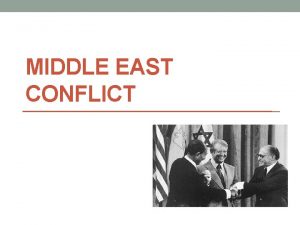Music of the Middle East The Middle East



























- Slides: 27

Music of the Middle East

�The Middle East is home to ancient civilizations and three of the major religions on Earth; Christianity, Judaism and Islam.

The Middle East � It is important to distinguish the major ethnic groups from this area as the cultures differ greatly from one another. � Arabic �Saudi Arabian Peninsula, Syria, Egypt, Iraq, Lebanon, Jordan � Persian �Iran � Turkish �Turkey

The Middle East �There are three major Islamic sects: �Shi’ah, typically more fundamental �Sunni, typically more mainstream �Sufi , the mystical branch of Islam �Depending on where you are in the Middle East, acceptance and/or avoidance of different musical activities will vary according to the type of religion practiced there. �What countries aren’t Islamic in the Middle East?

Defining Music � In Islamic and Judaic areas in the Middle East, there are different levels of music that exist. � Religious “music” is most often solo vocal performance, but it is typically not considered music at all, rather a form of Heightened Speech. Why? � Khandan: �“to sing, to recite, to read” �Recitation from the Koran, “Heightened Speech” �Islamic call to prayer Video

Defining Music �Musiqi: �The term for classical and folk music traditions. �This includes types of music that are considered halal, or acceptable, such as… �Chanted poetry, music for family celebrations, folk songs, and military music. �Other types of music may be considered haram, or unacceptable, such as Western pop music, music for nightclubs, or any style of music that has sexual or taboo content.

Listening Activity: Khandan �Listen to “Recitation of the Holy Koran” found in the Middle East Audio File. Follow the Listening Guide in your book as you listen. �What Sounds are you hearing? �What Behaviors are associated with this musical activity? Is this considered a musical activity by the culture that creates it? �What Conceptions or Ideas govern the sounds and behaviors of this musical activity?

Characteristics of Middle Eastern Music � The texture of traditional music in the Middle East is either: �Monophonic (one melody) or �Heterophonic ( multiple variations of one melody). � Ornamentations such as bent and embellished notes are frequently used. � Timbre is flat, vibrato-less tone, hard-edged, with a raspy quality. � Solo vocal music or solo instrumental music dominates. � Improvisation is highly valued.

Three Unifying Beliefs � Vocal and compositional style is derived from the recitation of the Holy Koran. � Music creates a kind of ecstatic, emotional bond between performer and audience. This emotional connection is referred to as tarab. � The “suite, ” or collection of individual pieces played together, is the major unifying compositional principle.

Musicians in Middle Eastern Society � How are professional and amateur musicians viewed differently? � How does the venue of a musical performance affect the value and acceptability of the music? � In general, the smaller and more private a musical activity is, the more acceptable and valuable it is primarily because music is an emotional activity (tarab). � Majles Video �A typical private concert event

Instruments: Chordophones � Oud (Arabic) Video �large pear-shaped lute �fretless neck �five courses of strings. �The oud is found throughout much of the Middle East and is associated with the “classical” tradition �Grandfather of all lutes � European lute � Chinese pipa � Japanese biwa

Instruments: Chordophones �Bouzouq (Arabic) �rounded-bodied plucked lute �movable frets �three courses of strings, one course for melody and two courses for a drone effect.

Instruments: Chordophones �Tar (Persian) Video �long-necked, plucked lute �movable frets �three courses of strings �sympathetic strings �mulberry wood “bowls” covered in lamb skin

Instruments: Chordophones �Kamancheh (Persian) Video �small round-bodied, bowed lute � 3 silk strings (traditional) or 4 steel strings, fretless �commonly called a spike fiddle �ancestor to the violin �name means “little bow”

Instruments: Chordophones �Santour (Persian) �Persian hammered zither or dulcimer, struck with two wooden mallets �Kanun (Arabic) �Arabic plucked zither

Instruments: Membranophones �Dombak �goblet shaped drums �various names in different regions �Daff, Riqq �frame drums �metal symbols are often attached �held vertically in hand

Instruments: Aerophones �Ney Video �end-blown flute �made from bamboo �Zornah, Surna �double-reed flutes

Middle Eastern Modal Systems � Maqam (Arabic) � Dastgah (Persian) � Every mode has a name that either indicates: �Origin, Character, or Theoretic practice � Every mode consists of a scale or set of pitches, an appropriate time and setting for performance, and an emotional “flavor. ” � Arabic Taqsim Video �A highly improvised song in free-rhythm that explores the mode, or maqam.

Listening Activity: Arabic Taqsim �Listen to “Arabic Taqsim” found in the Middle East Audio File. Follow the Listening Guide in your book as you listen. �What Sounds are you hearing? �What Behaviors are associated with this musical activity? �What Conceptions or Ideas govern the sounds and behaviors of this musical activity?

Persian Musical Terms � Dastgah �The mode or system of rules for Persian musical composition and performance. � Gusheh �Short composed melodies that are memorized and connected within each dastgah. � Radif �A book containing 250 -300 gusheh for each dastgah by a particular composer.

The Persian Suite �Pishdaramad �Introductory piece, composed, metric, ensemble performance �Chahar Mezrab Video �Composed, metric, solo performance on the santour �Avaz �Central piece, improvised, metric, vocal or instrumental �Tasnif Video �Composed, metric, vocal and instrumental ensemble piece �Reng �The final piece, based on folk dance traditions

Listening Activity: Chahar Mezrab �Listen to “Chahar Mezrab” found in the Middle East Audio File. Follow the Listening Guide in your book as you listen. �What Sounds are you hearing? �What Behaviors are associated with this musical activity? �What Conceptions or Ideas govern the sounds and behaviors of this musical activity?

Improvisation in Middle Eastern Music � Although highly regarded, there are many restrictions regarding improvisation. � Mode determines the scale and identity of pitches, and the typical motifs that must be used � Performer must follow form and overall design of the performance � Limited set of improvisational patterns � Movement from lower to higher range � Modal modulation, with limitations, at precise points

Sufism: Mystical Branch of Islam �Unlike other Islam sects, Sufis believe that music is THE way to attain union with Allah. �Many Middle Eastern musicians, if they are Muslim, are members of Sufi sects. �The whirling dervishes, a Turkish Sufi sect, and the Sema ceremony. Video

Umm Kulthum Video �Umm Kulthum is know as the “Voice of Eygpt” in the Middle East during her lifetime and beyond. �What is the instrumentation of Takht and Firqa ensembles in Eygpt? Western Influence? �How does her stardom contradict Middle Eastern values towards musical performance?

Listening Activity: Umm Kulthum �Listen to “Umm Kulthum” found in the Middle East Audio File. Follow the Listening Guide in your book as you listen. �What Sounds are you hearing? �What Behaviors are associated with this musical activity? �What Conceptions or Ideas govern the sounds and behaviors of this musical activity?

Influence and Current Issues �How has Middle Eastern musical culture affected other societies? �North Indian Hindustani culture. �Instrumental influences. European lute, most popular Renaissance instrument, derived from the oud. �What are current issues surrounding music in the Middle East? �Authenticity �Recovery and preservation of older folk and classical traditions �Participation of female musicians �Desirability or avoidance of musical modernization and Westernization
 Music music music
Music music music Laissez faire theory
Laissez faire theory What music that employs electronic music?
What music that employs electronic music? Instrument used in pamulinawen
Instrument used in pamulinawen Romantic period instrument
Romantic period instrument Music appreciation elements of music
Music appreciation elements of music Korean music traditionally associated with the lower class
Korean music traditionally associated with the lower class East is east and west is west
East is east and west is west West north west wind direction
West north west wind direction Sacred music of the middle ages
Sacred music of the middle ages Conflicts in the middle east comprehension check
Conflicts in the middle east comprehension check Middle east countries and water
Middle east countries and water Nationalism in africa and the middle east
Nationalism in africa and the middle east East coweta middle school
East coweta middle school Map of the middle east countries
Map of the middle east countries Middle east background
Middle east background Middle east crossroads of the world
Middle east crossroads of the world Location of ukraine
Location of ukraine Is middle east in asia
Is middle east in asia Doing business 2012
Doing business 2012 Decolonization in the middle east
Decolonization in the middle east Why is it called the middle east
Why is it called the middle east Three peninsulas of the middle east
Three peninsulas of the middle east Chapter 18 section 4 conflicts in the middle east
Chapter 18 section 4 conflicts in the middle east Middle east map
Middle east map Middle easy map
Middle easy map Three peninsulas in the middle east
Three peninsulas in the middle east Middle east before islam
Middle east before islam






